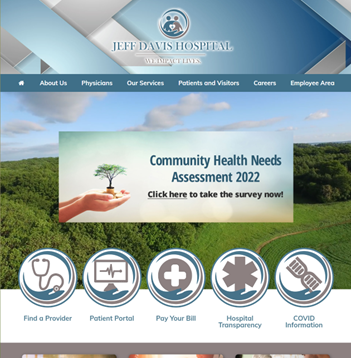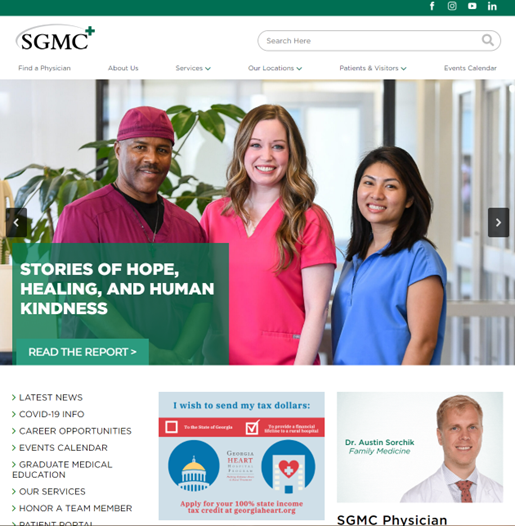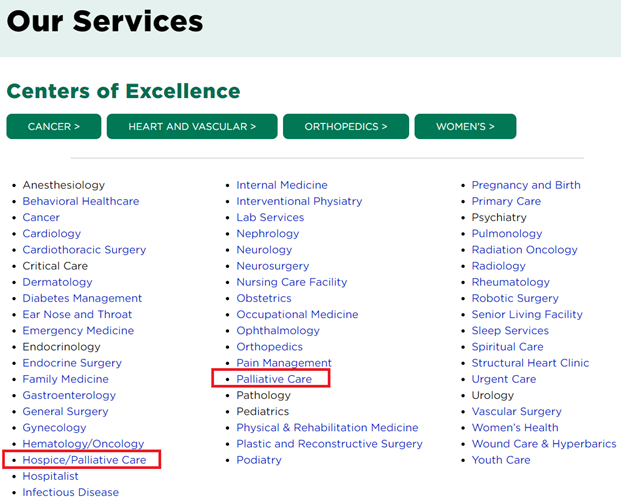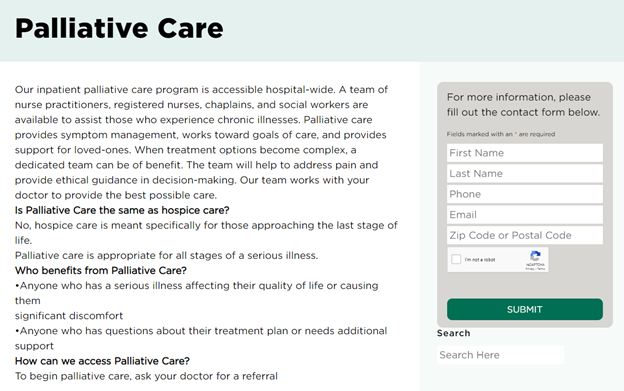By Matthew Post
Subject Website: https://www.jeffdavishospital.org/

Website Description:
This website represents a small hospital located in Hazlehurst, Georgia, a small town about 100 miles west of Savannah. The website serves as its public-facing virtual hub for those seeking information relating to its services in patient care, employment opportunities, patient portal access, hospital and provider information, and health topic research resources.
User Description:
The user is a 37-year-old woman with a graduate-level education and a profession in healthcare. She owns and operates a private clinical practice in the field of behavioral health, so she is very familiar with navigating various healthcare-related websites such as health insurance (payer) and government policy sites. She describes herself as “highly analytical, but easily frustrated” by poorly designed websites and portals, and “[doesn’t] understand why they make it so hard to use them”. She was concerned about the pacing of the user test, as she described preferring taking her to her time navigating a website and didn’t want to feel rushed into making mistakes or missing things.
Testing Methodology:
The user testing methods that I employed was Concurrent Think Aloud (CTA) and Retrospective Probing (RP). I chose a synthesis of these moderating techniques to maximize my data capture for testing by collecting in-the-moment thoughts from the tester, while also collecting information from their experience post-test with their complete attention and ability for more focused dialogue and feedback. During the testing, I had to ask the tester repeatedly to provide continuous feedback as they struggled to split their focus on the actions of their task and narrating their thoughts throughout as part of the CTA technique. Post-test RP allowed for a more deliberate description of their thoughts and actions during testing.
User Tasks:
I described the scenario as the following:
The user is an adult-child of an elderly father who has recently suffered a stroke at his home, outside the small town of Hazlehurst, GA. The father was initially seen at his local hospital, Jeff Davis Hospital, but was transferred to a larger, more comprehensive hospital in a city several hundred miles away to undergo surgery. The father has successfully completed the procedure and has asked the user to help him to be transferred back to Jeff Davis Hospital for recovery and rehabilitation, so that he can be closer to home and his elderly wife. The tester is using the Jeff Davis Hospital website for the first time to see if she can have her father transferred back to recover, learn more about stroke, and to see what elderly-specific outpatient care coordination is available after being discharged.
The user realizes that she knows very little about stroke. She listened her father’s care team describe his condition and treatment, but they used a lot of terms that she wasn’t familiar with and was too embarrassed to ask. She wants to learn more about stroke and its treatment, and since she is helping her father transfer back to Jeff Davis Hospital, she wants to know what information resources the website has available to research this topic. The first task is to leverage the website to learn more about stroke.
The user’s father was adamant about being transferred back to Jeff Davis Hospital. The staff at the hospital he is currently in said it was not uncommon for patients to be transferred to other hospitals, but they were not sure about this specific hospital. The next task is to use the website find out if Jeff Davis Hospital accepts patients for inpatient recovery and rehabilitation.
As part of the user’s concern for her father returning to the smaller hospital, she needs to investigate what resources are available to him after he goes home to further recover after his inpatient stay. The user wants to find out what outpatient services are available to him upon discharge to assist in managing his recovery and transition. The final task is for the tester to use the website to discover what elderly-specific care coordination programs are provided by the hospital.
Testing Analysis:
- The first task for the user was to use the website to research stroke. The user spent a few minutes orienting themself to the landing page and the available options. The user skimmed the top options by hovering over them one by one, revealing the drop-down menu of sub-option items for each option. The user spent a majority of their time on this page reading and re-reading through the “Our Services” menu options looking for a relevant selection for searching for medical conditions. The user noted the lack of a search bar field available on the landing page, as she indicated the desire to simply search for the keyword “stroke”.
The user eventually found the “Education” option under the “Patients and Visitors” main menu item. The user was initially confused with the addition of the left panel menu options, as it was a duplication to the already available and used top-center main menu sub-options; she scrolled through the list even though they were exactly the same as the options she already browsed to arrive on the “Education” page. She then scanned the limited content of the page and determined that this was not what she was searching for.
The user then re-examined the options for some time before selecting the “Health Research Center” option. Upon loading the page, she immediately selected the image on the right side of the page representing the “FastHealth” search engine. After several minutes of laughter and questioning the authenticity of the displayed page, the user began to scan the available links presented in described “migraine-inducing color palette selection”. After several time-filling comments about the absurdity of the design of this page while continuing to scan, the user did locate the “stroke” option. The stroke page featured the same user described “terrible design” with “too many” options that provide no description of what they are. The user clicked through many of the available “Top Stroke Sites” options, finding a mixture of highly reputable medical research organizations and other healthcare sites that had “suspiciously generic” names that made the user question its authenticity or reputability. One source was from another country that recommended calling “999” if experiencing an emergency, which would not connect a caller in Hazlehurst, GA to the appropriate emergency response.
The “FastHealth” search engine informational page for stroke made available on the Jeff Davis Hospital website appears “crude, confusing, and frankly, assaulting to the visual senses” according to the user. The strange formatting of the content, too many options, the clashing visuals, and the lack of supplemental information describing the available links lends to an uncomfortable consumer experience, as the user feedback states.
- The second task was for the user to investigate and determine whether Jeff Davis Hospital allows the transfer and in-patient stay of patients in recovery and rehabilitation after surgery. The user returned to the main landing page for the hospital website and began scanning the “Our Services” options. After spending some time going through the options, the user selected the “Respite Care” link; after reading the brief content on the following page, she determined that this was not the information she was seeking. The user then selected the “Surgical Services” option, read the page content, and asked if she had found the appropriate information; the user was minimally encouraged to continue searching. After another brief scan of the “Our Services” options, the user selected the “Swing Bed Program” option and found the information she was searching for.
- The final task was to find elderly-specific outpatient care coordination for her father upon discharge from the hospital. The user again scanned the “Our Services” options, almost selected “Respite Care” again but opted for “Hospice Care”. Upon reading the words “terminally ill”, knowing this does not reflect her father’s status, returned to the “Our Services” options, scanned once again, and selected “Harmony Center”. Even upon reading the content of the page, the user was unsure if this was the desired information for the task – it was.
Design Recommendations:
- Addition of a search bar on all website pages. With the addition of a functional search bar, users can simply search by keywords to find the website content they are searching for.
- The addition of brief, descriptive, supplementary text to display, or appear after hovering, under each menu option selection. Users should have an idea of what the following page selection content provides without having to visit that page, especially if there are medical or non-standard language terms being used.
- Remove the redundant display of sub-category options on the left panel; the duplicate display of these options only crowds the screen unnecessarily and confuses the user as they have already used the top center main option selection to reach a page that displays it.
- Remove the image-link of the “FastHealth” search engine landing page from the “Healthcare Research Center” page. Present the available categories in text, in alphabetical order on the page.
- Completely re-design the “FastHealth” search engine with a more modern, aesthetically appropriate design. Introduce improved Jeff Davis Hospital branding. Eliminate or better organize as many options as possible (i.e., consolidated options or sub-pages) to present a more streamlined and minimalist design. When presenting links to external resources, provide brief detail text describing the resource and its authority on the subject matter. If this is not possible, remove the “Health Research Center” page completely.







